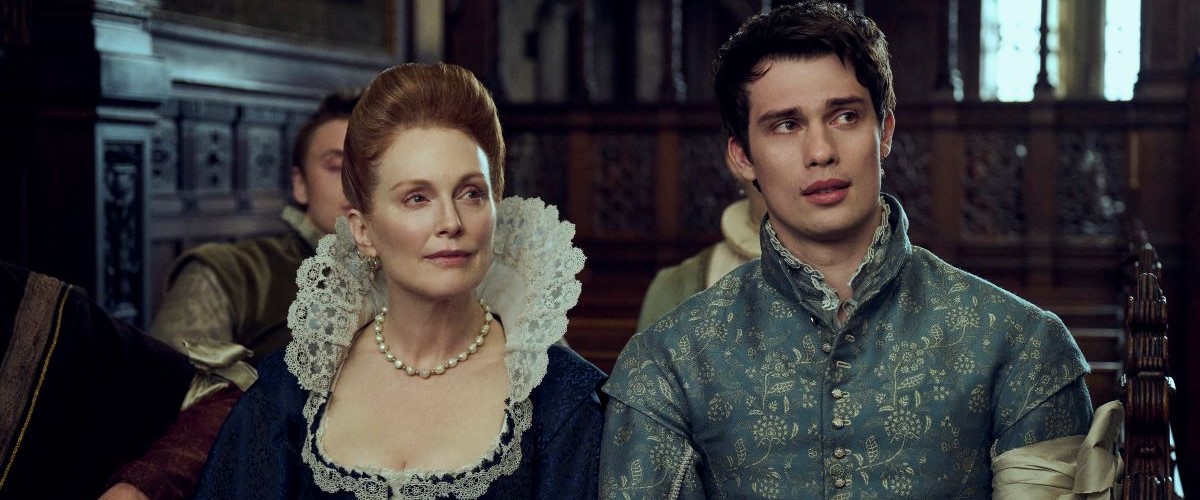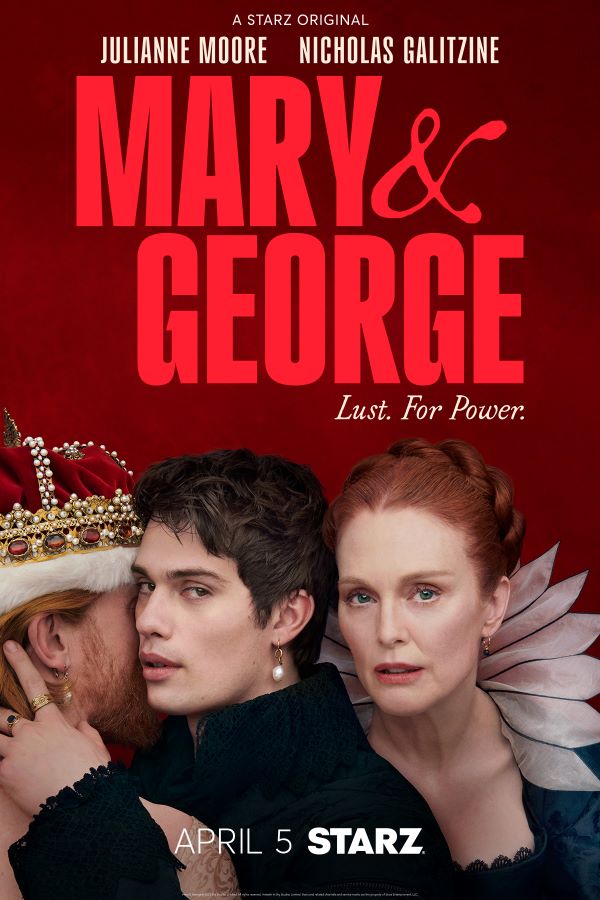If post-Elizabethian court intrigue isn’t your thing, know that Starz has done its best to ensure its new drama “Mary & George” appeals to edgy, modern viewers. There are enough F-bombs to make Tarantino blush and so, so many naked bodies. This is a show with a plethora of sex scenes, in every combination consenting adults could ask for.
In the show poster, Julianne Moore and Nicholas Galitzine are making eye contact with us. They’re seductive and powerful and smart, which sets up well the seven-part series that follows. In it, Moore and Galitzine play a mother-son pair of strivers, rising from the outskirts of British nobility to the inner sanctum at the beginning of the 1600s (periodic year markers help audiences keep track).
It’s based on a true story, liberally adapted from the popular book The King’s Assassin. Historians still debate if George Villiers killed King James (1 in England, 4 in Scotland—here played by a horny, if weary Tony Curran). The record is also not totally settled about whether the two men were friends or friendly friends. “Mary and George” is decidedly Team Sex although it’s a bit weird about it.
Early we see Moore’s Mary Villiers, hot off the death of her first husband, decide to marry again for financial stability. She convinces a grumpy but fundamentally decent Sir Thomas (Sean Gilder) relatively quickly, offering him society-sanctioned, marital sex. Later, Mary steps out with working girl Sandie (Niamh Algar), and their pairing is romantic and tender. Which fine, maybe Mary’s specific experiences were really like that.
But Galitzine’s George gets a tonally different and functionally problematic arc. He has some perfunctory straight sex before beginning to sleep with men and the show treats those man-on-man (and sometimes on-man-on-man-on-man-on-man) encounters as salacious in a way it doesn’t with its other pairings. And it’s not just that sodomy was frowned on at the time. It’s the music, the lighting, the details of who’s on top and what they use for lube—the choices the series makes in presentation and tone—that marks this kind of sex as more titillating, yes, but also more morally questionable.
In its presentation of its many acts of coitus, “Mary & George” appears to be toying with the stereotype that gay men are inherently promiscuous and their acts of lovemaking are all carnal desire and no romance. In fact, it takes just one same-sex encounter (naturally, for this show, a threesome) to turn the naive, romantic George into a power-hungry dandy, willing to trade sex for status where before he only saw an expression of love.
Part of the problem may come from the show’s stars and their places in our current society. Galitzine is doing what he’s known for: playing an omnisexual noble whose beauty determines his path. Or at least that’s where we start. As “Mary & George” continues, particularly once we get past the orgy-rich first three episodes, George morphs into more than the ingenue. He’s gained the King’s bed by then, becoming the monarch’s primary confidant and gotten all the power that comes with it. For the following four episodes, his journey becomes much more nuanced and Galitzine chews the role up.
It’s no longer the tired story of seducing one powerful man but rather about the effects of power. What will George do with his new station? How will it change him? How will he use it to change his nation and Europe at large? Yes, these questions are more typical of period pieces but it’s a common genre for a reason. When “Mary & George” gets around to asking them, it gets more interesting, no longer just trying to shock us with 17th-century sex. Instead, in the season’s back half, its talented actors and specific setting reveal something dark but essential about the human condition, beauty, and bravado.
As is to be expected of an actor of her status (she also executive produces), Moore thankfully escapes portraying the sexual details Galitzine enacts. Mary may trade in sex just as she positions her son to do, but she has other skills to deploy. Her ruthless disposition and keen understanding of human nature get her and her whole family ahead. Multiple times, she articulates that she’s after power for power’s sake and that her hunger for it will never be satiated. She’s not trying to be a good person, but she is good at the game she’s playing, not perfect, but strong and successful.
Moore does here what she does so well, bringing a bit of humanity to a character who could be a snarling villain. Under her care, Mary is an anti-hero—we root for her despite knowing we should not. The compromises she makes, the petty vengeances she latches onto, the few misjudgments she acts upon, those are what really powers this series.
In the end, the moral is unclear. Both Mary and George are rewarded and punished for their bad behavior (good deeds being fewer and further between). The show here isn’t having its cake and eating it too, but rather exposing the historical record. In real life, these two unsavory underdogs rose quite high, succeeding by some measures and failing by others.
Upon completion, “Mary & George” leaves a lingering sense of questions. Not about right or wrong but about how power works, the dangers of ego, and the nature of greed. In those aspects, the show is smart and provocative. Oh, and it shows a lot of butts too.




















